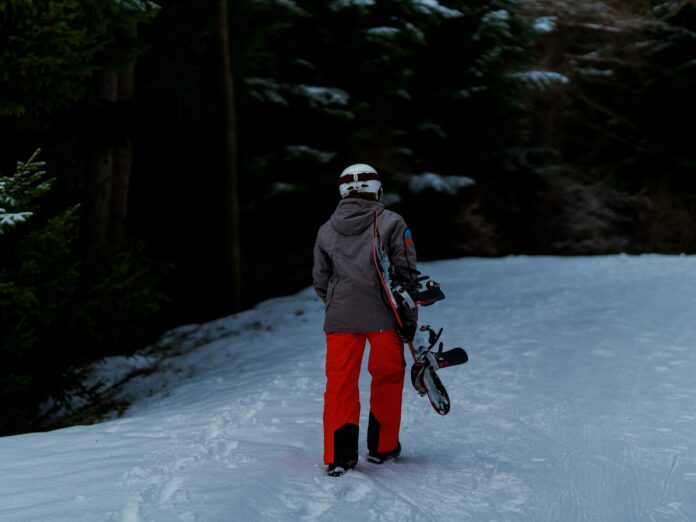In recent years, as self-proclaimed foodies very vocally seek more and more genuine Thai eating experiences, there’s one dish that stands at a strange kind of crossroads.
Universally loved, sure, but also unfairly maligned by many Thai food aficionados in the west, the clearly delicious Pad Thai is often dismissed as too sweet, too cloying, or, weirdly, insufficiently ‘authentic’.
Of course, a som tam with the funkier fish sauce and plenty of paddy crabs is incredible. And yes, we’re sure that jungle curry you made in your Doi Suthep cooking class was the real deal. But let’s not fuck about here; a good Pad Thai is still a sensational plate of food.
It’s the shortcut-taking, half-arsed versions that are to blame for Pad Thai’s sometimes less than favourable reputation, with gloopy ketchup spiked international incarnations meaning the dish is misrepresented and misunderstood.
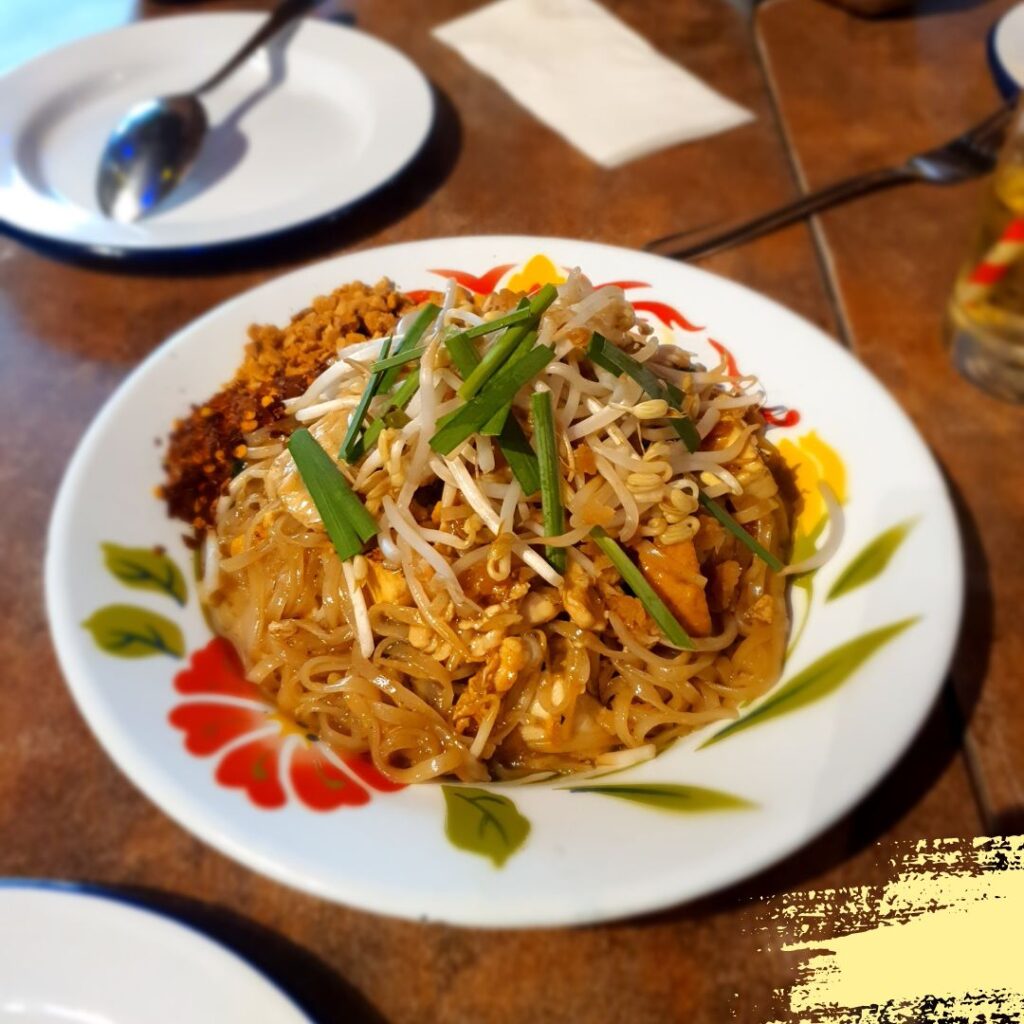
Now, about that ‘too sweet’ accusation; you see that lime on the side of the plate? It’s there to subdue, to balance and to lift. The ground chilli, the chopped peanuts, the fish sauce… as with the vast majority of Thai noodle dishes, this is a democratic affair, with condiments available so you can season and customise to taste.
Although the probability of a Thai person choosing Pad Thai as their favourite dish is rare, it’s a dish that deserves more love than the sceptics give it credit for.
Indeed, for many Pad Thai has become a national emblem of Thailand, which was actually the whole intention of the dish in the first place, having been introduced during the 1930s and 1940s by Prime Minister Plaek Phibunsongkhram as part of a campaign to assimilate Chinese influences on the country’s cuisine, promote Thai national pride and reduce rice consumption during a time of economic hardship. By encouraging the nation to embrace this noodle dish, he aimed to foster a sense of unity and national identity. Thus, Pad Thai was born not just as a delicious dish, but also as a symbol of resilience and cultural pride.
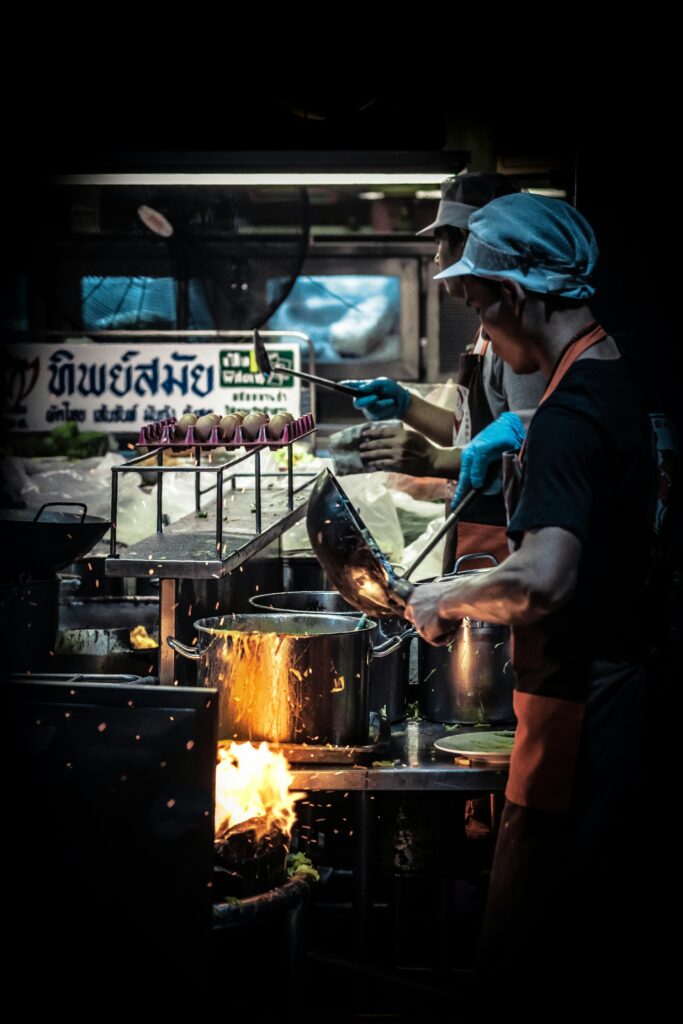
Pad Thai contains a fairly strict, concise set of ingredients — rice noodles, shrimp, fish sauce, tamarind, tofu, bean sprouts, spring onions, peanuts — and due to this, the dish’s success lies in the details; in the smokiness achieved by a jet engine wok burner, in the chef’s deft but delicate flick of the wrist, in the plumpness of the prawns and the secrecy of the sauce. Therefore, and because Bangkok is so massive and versions of Pad Thai surprisingly divergent in quality, we’ve kept this list short, concise and to the point.
Without further ado, here’s where to find the best Pad Thai in Bangkok.
*Like many places in Thailand some of these restaurants, shophouses and streetfood operations may be randomly closed – opening hours are unpredictable, so it’s wise to have a backup. Generally speaking, you should expect to pay in the region of ฿100 (around £2.50) for a good Pad Thai in Bangkok, though that of course depends on the endless options for customisation available. If prices are significantly more than that, we’ll make sure to mention it.*
Thip Samai (Pad Thai Pratoo Pi Ghost Gate), Phra Nakhon
We had to start here. Even though Thip Samai isn’t perhaps our personal favourite, to many it is the best Pad Thai in Bangkok. It’s certainly the most famous.
Known as Pad Thai Phratoo Phi (Ghost Gate Pad Thai) because of the restaurant’s location close to a crematorium, this is without doubt an exemplary rendition, having been slinging their stuff since the ‘60s.
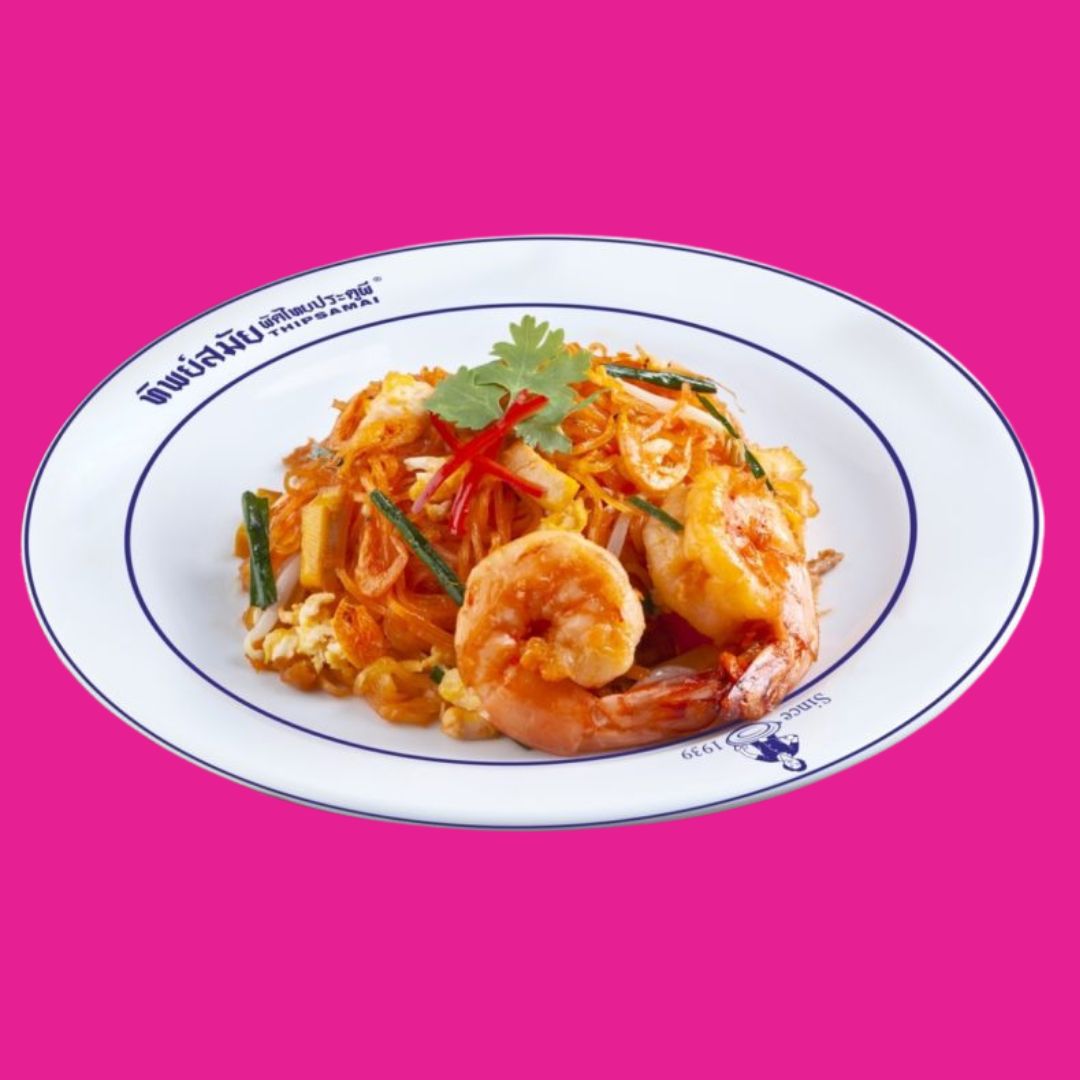
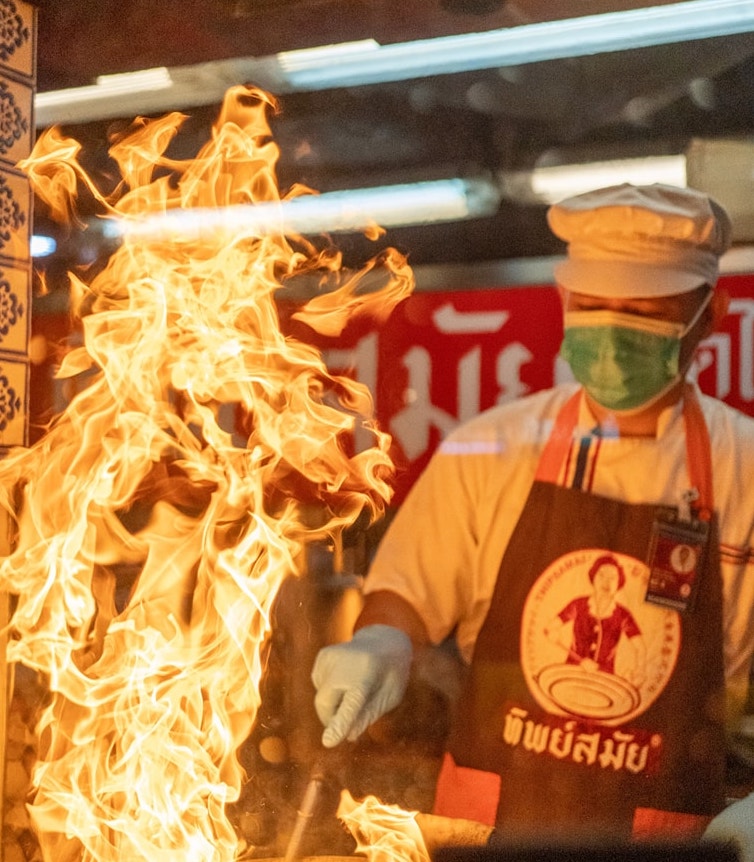
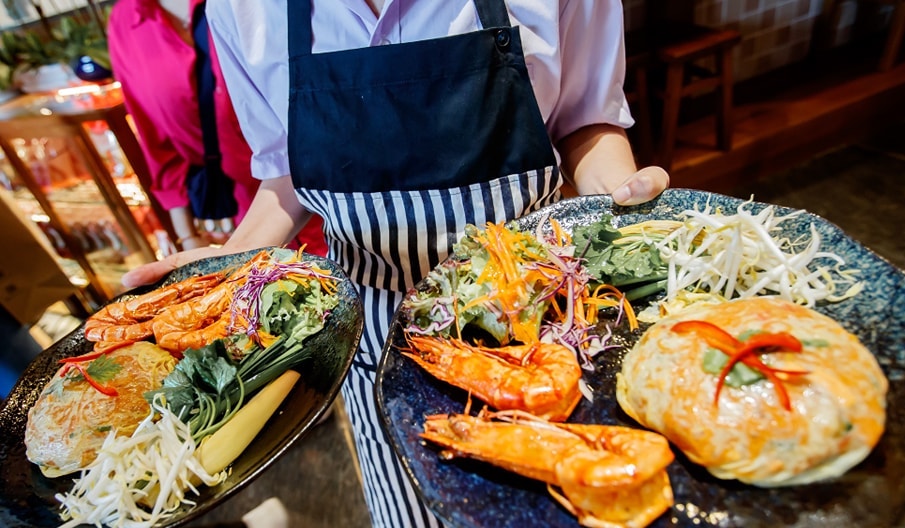
If you’re on Google you’ll probably read that the noodles here are overrated (hey, when is someone not pontificating along those lines on Google?). But that doesn’t stop people from coming here. This is one of the oldest Pad Thai establishments in the capital, with a version made special by the addition of prawn head juice in the secret sauce. This small tweak to the recipe (historians believe that Pad Thai was the first standardised recipe in the Thai culinary canon) garnered plaudits from then Prime Minister Plaek Phibunsongkhram, which in turn unleashed a wave of popularity that Thip Samai is still riding, and sees queues snaking round the block to this day.
Cooked on an industrial scale in massive batches over roaring hot woks, the Pad Thai at Thip Samai has a luminous, almost US Fanta-like hue. Served up ‘as is’ or wrapped in an egg, the dish is unceremoniously plonked on a plate, Jackson Pollock style, in the name of speed. That queue is getting restless, after all. If the orange overload isn’t too much, order a glass of Thip Samai’s freshly squeezed stuff, which is excellent.
Whilst the plate looks chaotic, the version here has a subtle smoky flavour and meaty shrimps, the latter of which can be upgraded to jumbo size for ฿250 or so. Honestly, we wouldn’t bother; those big boys throw off the balance of the dish somewhat.
Instead, go simply for the Pad Thai sen jan man gung – a classic prawn rendition but with those saline, buttery prawn head juices mixed through. Savour the luscious umami, baby. To add that thin omelette gift wrapping paper we spoke of, it’s Pad Thai haw gai gung sot. Lovely stuff.
Though there are now multiple branches across Bangkok, including at the swanky ICONSIAM, and even Pad Thai cooking kits available to take home, it’s at Ghost Gate that the original (and best) is still thrown down.
Website: thipsamai.com
Address: 313, 315 Maha Chai Rd, Samran Rat, Phra Nakhon, Bangkok 10200, Thailand
Lueng Pha Pad Thai, Phra Nakhon
Thip Samai not open or just completely, obstructively rammed? Well, you’re in luck. Because right next to Thip Samai on Mahachai Road (likely a deliberate choice in anticipation of overspill and impatience), you’ll find a superb Pad Thai at Lueng Pha Pad Thai, a six-decade deep family run operation that understands that the devil truly is in the detail.
It’s a humble setup here. A luminous lime green, smoke stained interior with walls adorned with old school photos offers that surefire sign of a recipe that’s been perfected over generations. A charcoal stove at the front of the store – sparks shooting off in all directions – provides some theatre. The clatter of the hoak and the whoosh of the wok burner bring with them aural intrigue. Yep, the mise en scene is set for something spectacular.
And so it comes to pass. Though smaller (cheaper, too) than its neighbour, the Pad Thai at Lueng Pha is arguably even better. Made single to order rather than in Thip Samai’s whopping batches, there’s a pronounced wok hei to proceedings here, lifting the signature prawn oil pad Thai to dizzy new heights not scaled next door. Take a seat out front on the pavement next to a fan for a humble but also luxurious dining experience.
Address: QG33+4WW, Maha Chai Rd, Samran Rat, Phra Nakhon, Bangkok 10200, Thailand
Pad Thai Fai La Tu, Dinsor Road, Phra Nakhon
Having won a Michelin star for his New York restaurant Rhong Tiam back in 2010 and, more recently, with Table 38 back in Bangkok (his hometown), it’s clear that chef Andy Yang has some serious experience in the world of Thai restaurants.
Though both have now sadly closed, you’ll find the same precision technique and innate feel for the country’s cuisine at chef Yang’s Pad Thai Fai La Tu, a short stroll (and welcome escape, quite frankly) from Khao San Road. It’s home to a belter of a Pad Thai.
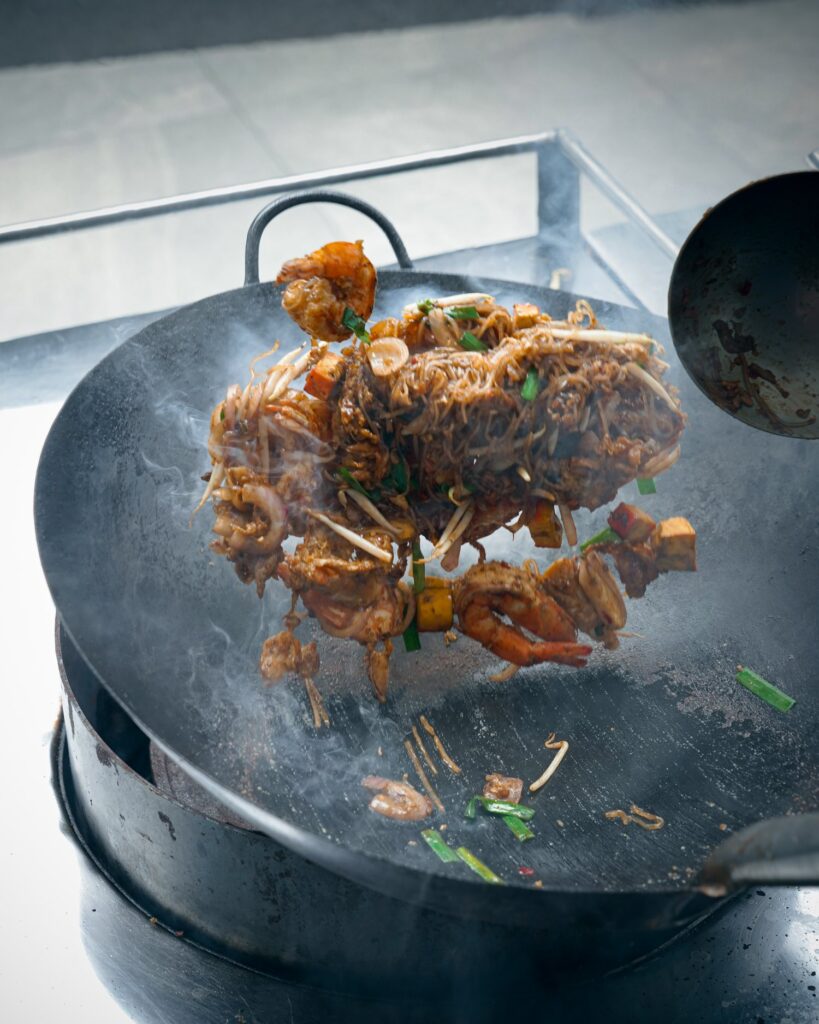
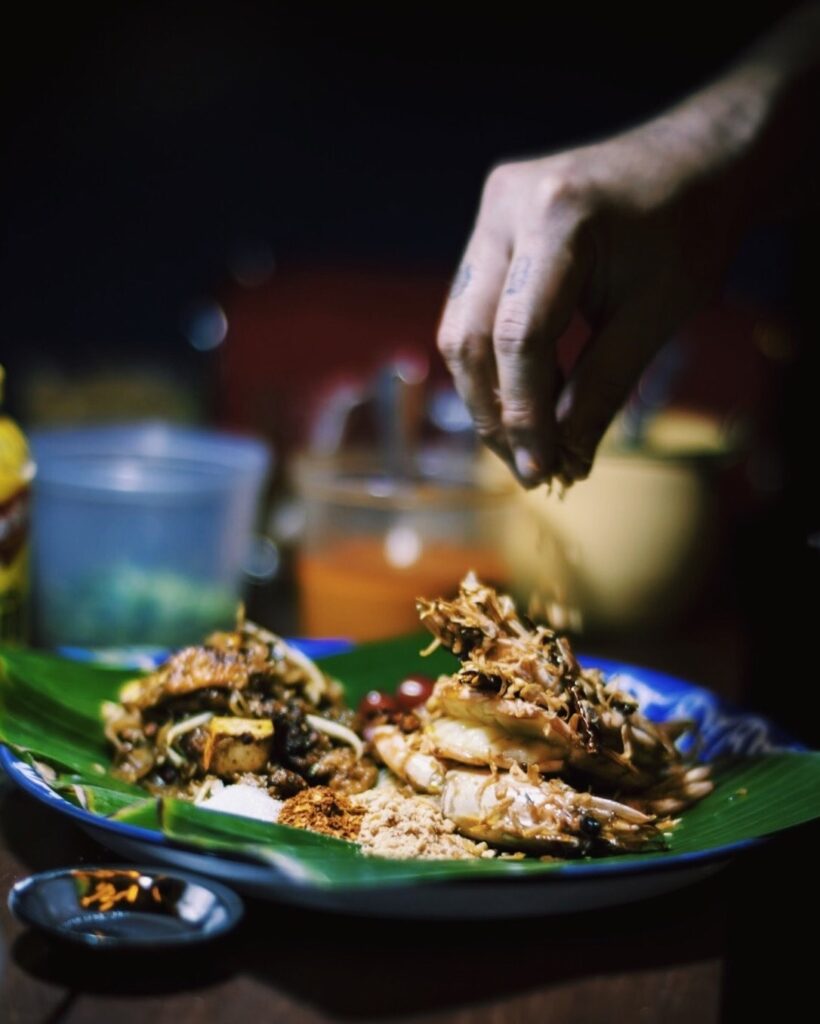
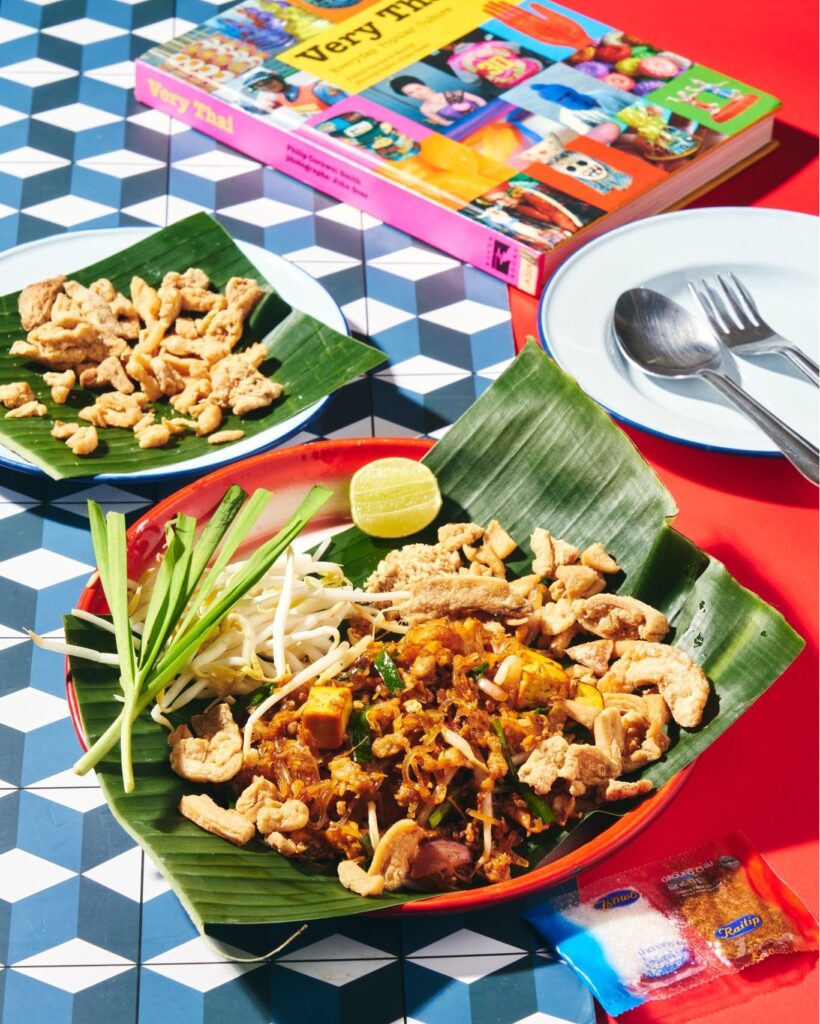
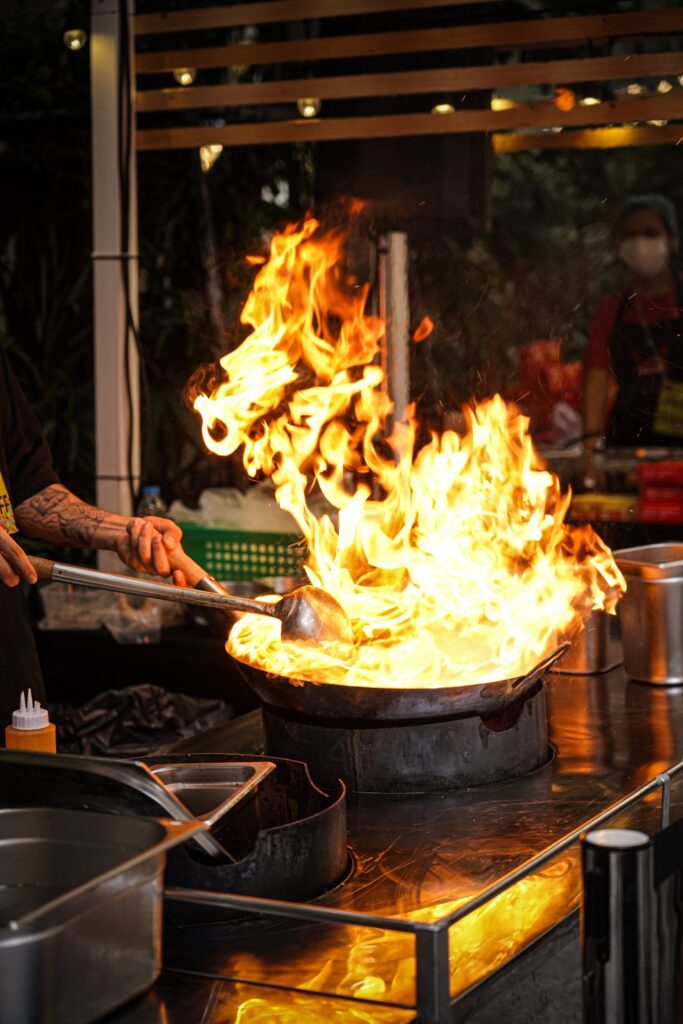
The most popular order here sees grilled slices of pork neck spread invitingly over a bed of Thailand’s famous noodle dish, all delivered on a banana leaf for a bit of added theatre. But it’s not just the Pad Thai moo yang which keeps the crowds coming back for more; the crispy pork Pad Thai is arguably even better, with four large chunks of fatty pork belly blessed with properly puffed pieces of crackling, all sitting alongside a charred tangle of noods and gubbins. Wowzers, it’s good, and evidence that Pad Thai doesn’t necessarily have to be a prawn-centric affair.
If Dinsor Road’s lack of proximity to an MRT or BTS station is putting you off, you’ll be pleased to hear that you can now find chef Yang’s Pad Thai at Siam Square Soi 10 and the Mahanakhon CUBE, too.
Read: The best street food close to Khao San Road
Address: 115/5 Dinso Rd, Baworniwet, Phranakorn, Bangkok 10200
Website: ผัดไทยไฟทะลุ Pad Thai Fai Ta Lu | Bangkok | Facebook
Pad Thai Narok Taek, Thonburi
The moment you’ve all been waiting for (and yep, we’re not sure why we haven’t listed this guy first, either): the best Pad Thai we’ve tried in Bangkok is at Pad Thai Narok Taek, located just across the river in Thonburi district.
Nicknamed ‘Mad Man Pad Thai’, owing to the chef/owner’s stir frying style – all controlled chaos and rock’n’roll moves – it’s said that chef Aon Apilak Plurksawet gets through 25 woks a month due to the incredible amount of orders (400 a night, and counting) he receives for this remarkably good version of the Thai classic.

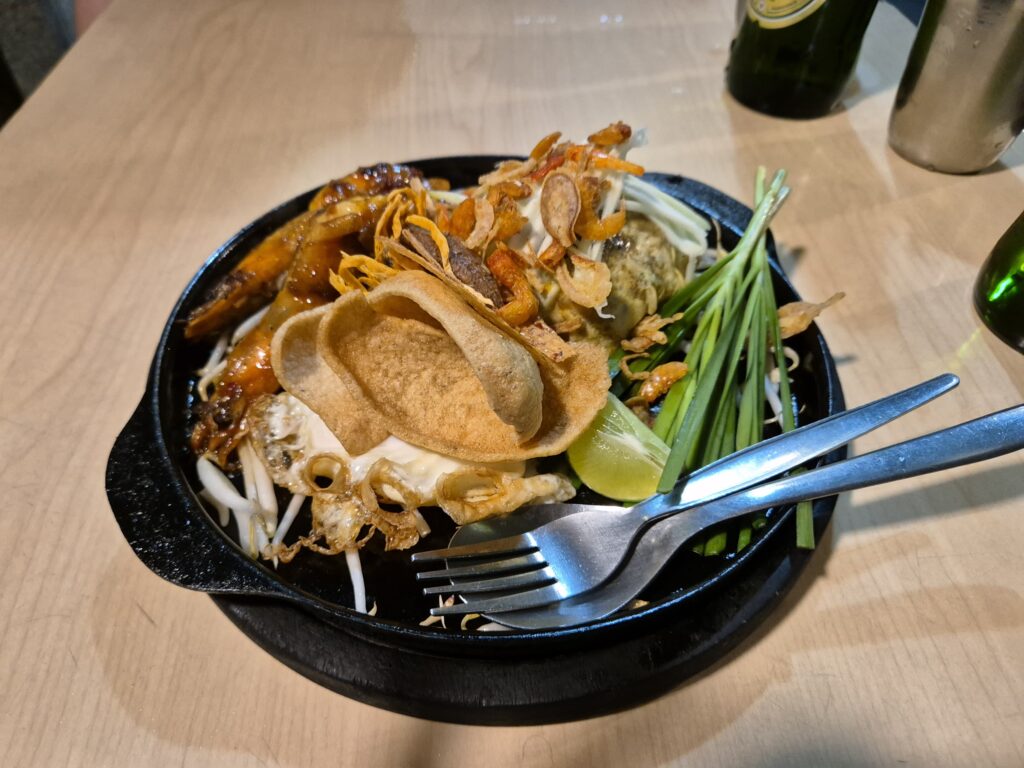
Scorched and moody, and a little tart rather than bracingly sweet, the dish is to be enjoyed on the street right next to Plurksawet’s cart. With no version of Pad Thai here clocking in at more than ฿100, it’s also an absolute bargain. This; this is the one you’ve been looking for.
So good, in fact, that we’ve included this one on our list of the 22 best street food places in Bangkok.
Address: 286 Lat Ya Rd, Khlong San, Bangkok 10600, Thailand
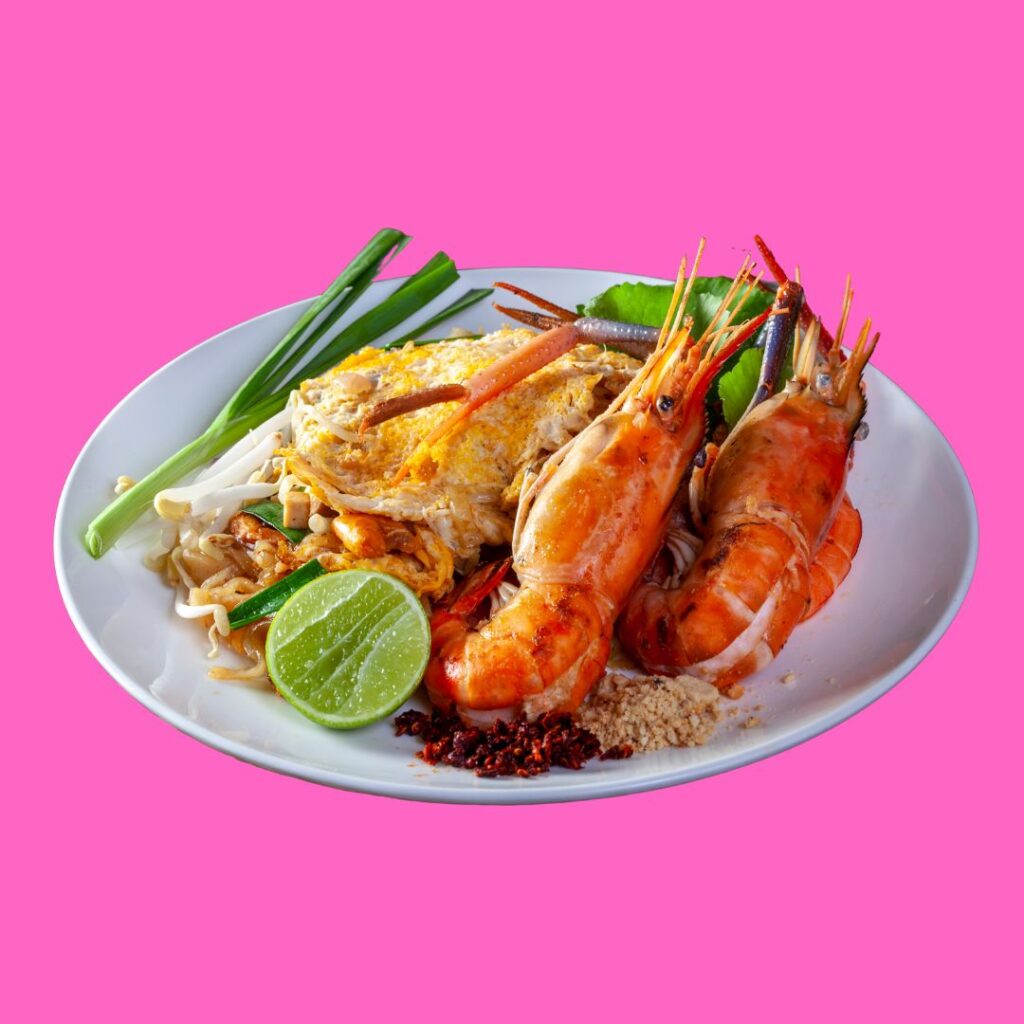
Baan Yai Phad Thai (Silent Pad Thai), Din Daeng
Ascend the three terracotta steps – a stairway to heaven of sorts – to Baan Yai Phad Thai. Reward your climb with a sit down on the collection of plastic stools seemingly at plinth level outside the shophouse. Settle in and wait for Bangkok Pad Thai mastery to commence…
Here, it’s a traditional, perfectly formed take on the classic, cooked by a brigade of chefs who are all hearing impaired, giving the restaurant its unique moniker.
Regardless of that faintly philanthropic seasoning, the queues have been huge for this place for years, even before Michelin bestowed Baan Yai Phad Thai with a Bib Gourmand award in 2020, prompting an upgrade from streetcart to shophouse Now, the queues stretch out for even longer, but the quality remains resolutely, reassuringly consistent.
Over a charcoal stove, every dish is made to order, with chef Somjet “Ae” Chuenyam’s liberal use of rendered pork fat a most welcome distinguishing feature. A topping of crumbled crackling is another fine touch that brings Baan Yai’s Pad Thai a luxurious quality. Squid and shrimp can also be added. You know what? We might add both!
Address: 110 Soi Inthamara 47, แขวงรัชดาภิเษก Din Daeng, Bangkok 10400, Thailand
Mayrai Pad Thai Bar, Phra Nakhon
In the mood for Pad Thai but want to enjoy it in relaxed, air-conditioned surrounds whilst clutching a glass of cloudy, funky wine? A fairly specific desire, granted, but one that will be satisfied at Mayrai Pad Thai Bar, the work of chef ThiTid “Ton” Tassanakajohn of Le Du fame.

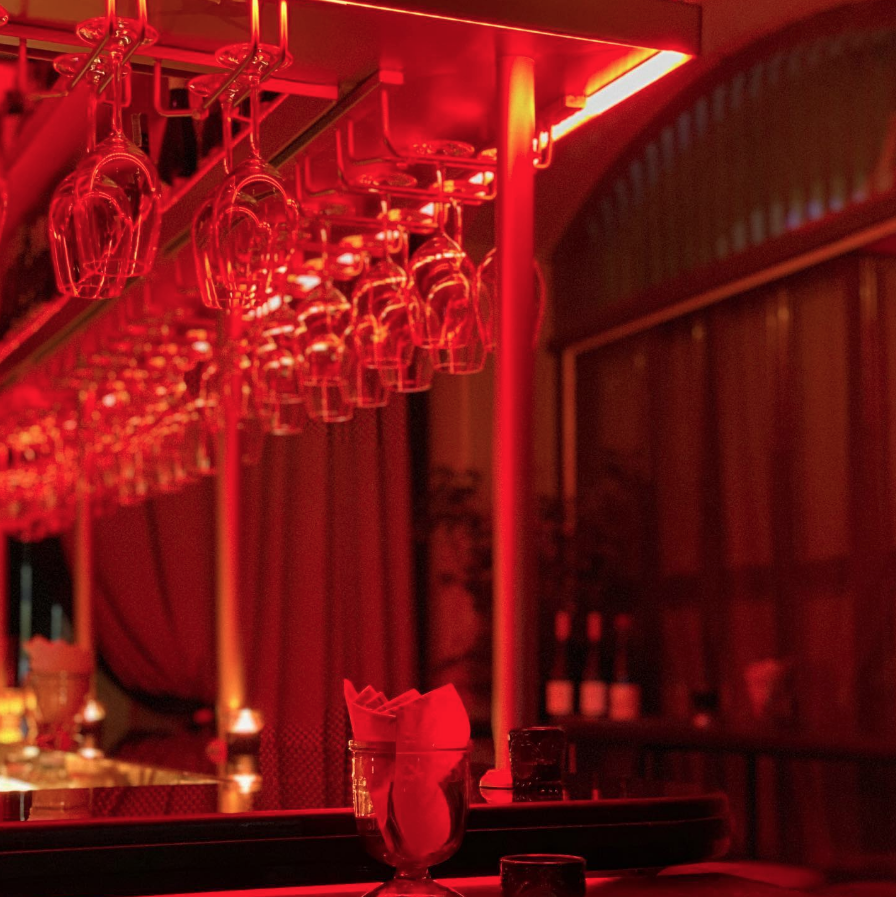
Whilst certainly delicious, this one is going to cost you; the Pad Thai with wagyu beef has got to be the most expensive in the city at ฿590 (around £12.50) but it’s well worth that premium price, all smoky bark and blushing centre. That said, our favourite order here is the Pad Thai with pork jowl, which arrives pleasingly pink and splayed out like it’s sunbathing.
Enjoy with a glass or two of natty juice and views of Wat Pho from a second floor vantage point, and feel about as far removed from some of the more street level entries on our list as is physically possible. For better or for worse, we might add…
There is now a second outpost of Mayrai on Wireless Road, housed within Baan, another of Chef Ton’s more casual restaurants.
Address: 22 Tha Suphan Alley, Phra Borom Maha Ratchawang, Phra Nakhon, Bangkok 10200, Thailand
Instagram: @mayraibkk
Baan Pad Thai, Bang Rak
Translating as ‘house of Pad Thai’, this restaurant is another premium Pad Thai purveyor, part of a restaurant group whose portfolio includes the acclaimed Issaya Siamese Club and Pizza Massilia, which features on our list of the best pizzas in Bangkok, incidentally.
Made with a secret 18-ingredient sauce, you can taste the thoughtful seasoning that goes into this one, its boujee unctuousness the result of – we’re guessing here – both prawn head juice and a little pork fat.
There are many different ways to measure the quality of a good Pad Thai, but the actual noodles aren’t often used as a barometer, it has to be said.
Not so at Baan Pad Thai, where the quality of the noodles is evident. Here, thin flat sen lek from Chanthaburi province (considered the country’s best) are used, bringing their distinctive chewy texture and a sense of structural integrity that doesn’t break down to mush under the heat of the wok.
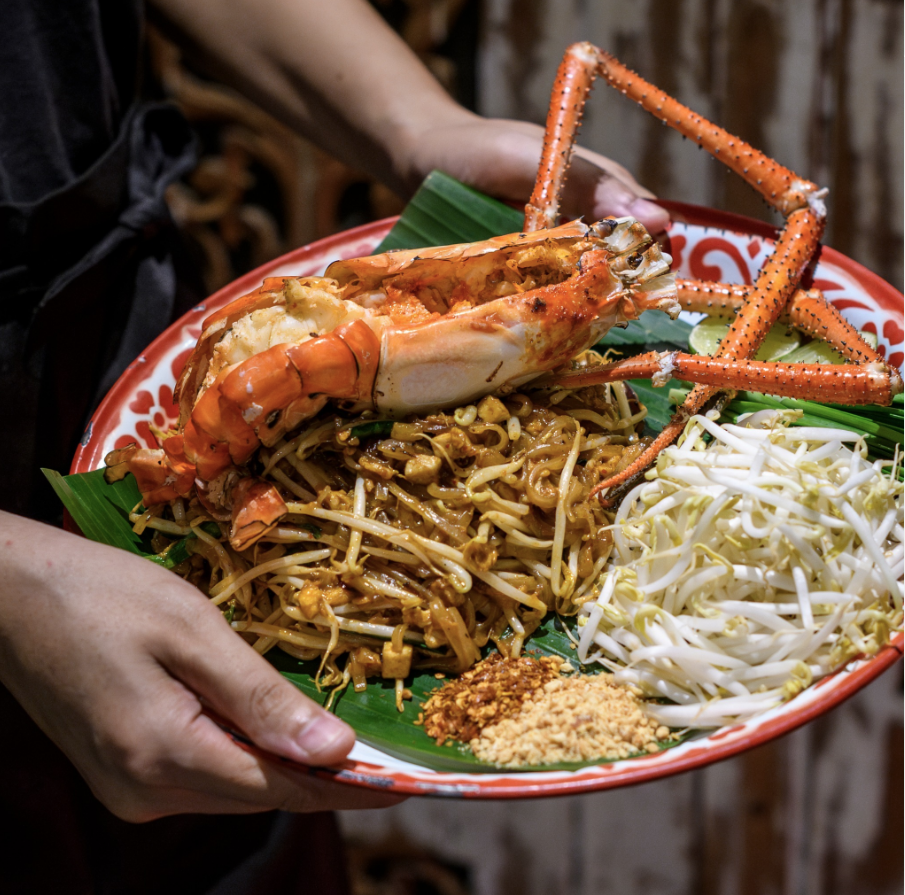
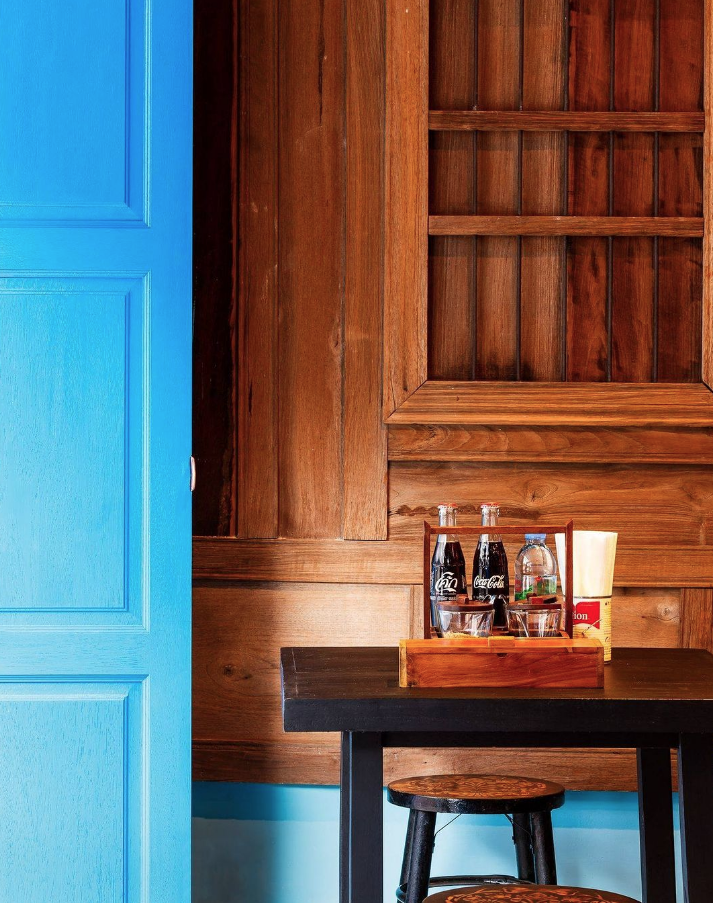
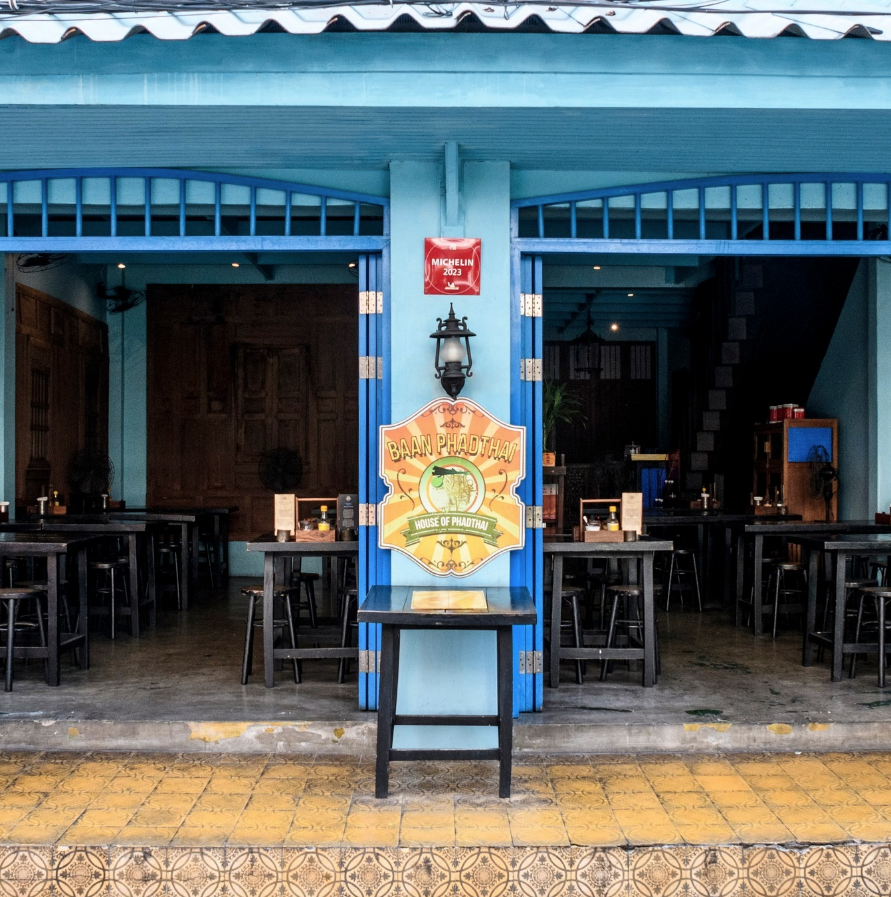
There’s further attention to detail in the reduced crab stock that forms the backbone of the secret sauce, enhancing the dish’s multilayered flavours and giving an umami-rich kiss across the chops.
The Pad Thai puu (Pad Thai with blue swimmer crab meat) is presented extravagantly, a tangle peeking out from under the crab shell, its claws wrapped protectively around the noodles, the flavour throbbing with the richness of brown crab meat. If you’re keen on sharing what is usually a one-dish-wonder, then the jumbo mud crab Pad Thai is built for it.
At heart, Pad Thai is an easily-made-vegetarian dish, and here the jay (vegetarian) version is excellent, silky from both the noodles and tofu and just as satisfying as the more meaty menu numbers.
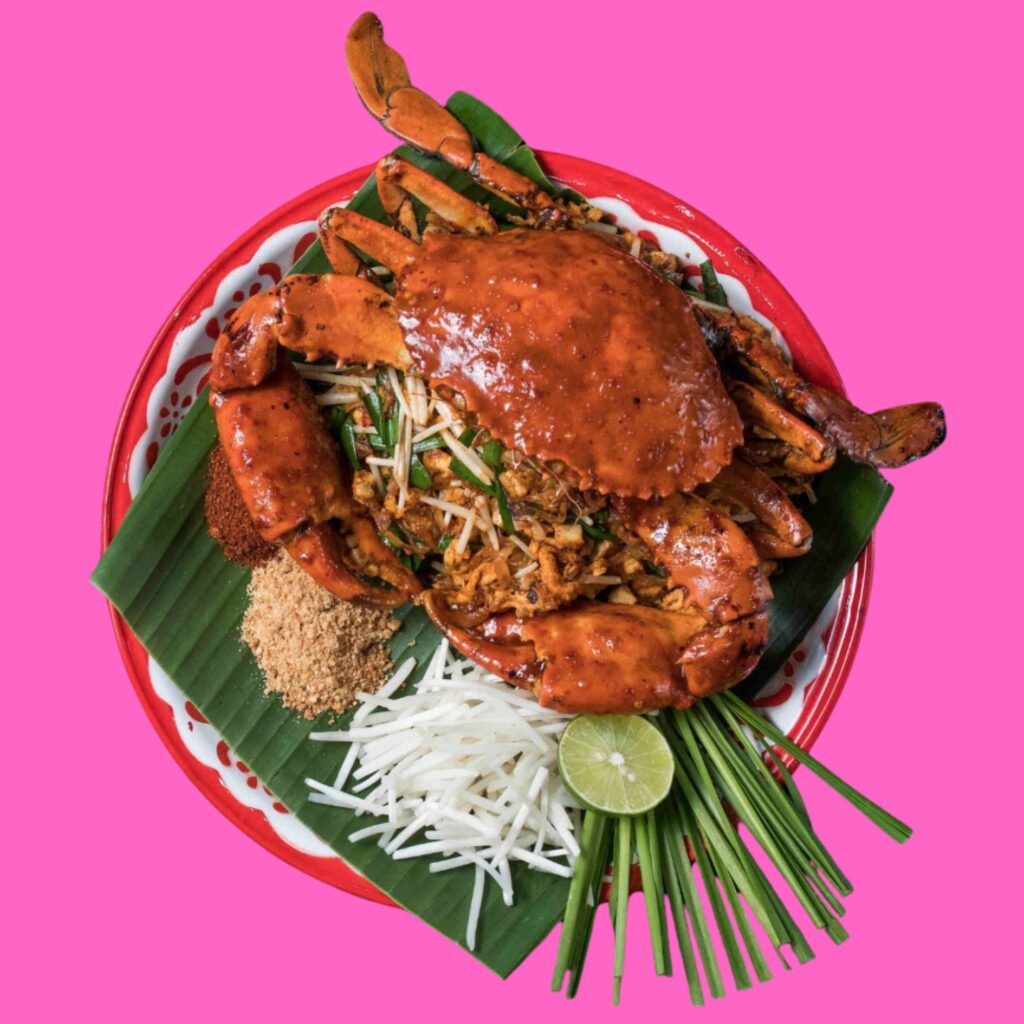
Regardless of your order, and for the sake of visiting farang, the Pad Thai here is served chilli free. There’s plenty of smoked, ground chilli tableside should you wish to pile it on, though.
The restaurant’s interior is charming, done up in blue with traditional antique Aytutthya wood partitions and panels, making it a spot you’ll be keen to recline in a little longer than the plastic stool operations on our list. Hmmm, perhaps we might order another…
Address: 21, 23 Charoen Krung 44 Alley, Bang Rak, Bangkok 10500, Thailand
Website: baanphadthai.com
Sawasdee Ratchawat, Dusit
Sitting pretty in the rather unassuming, laid back neighbourhood of Dusit, Sawasdee Ratchawat exudes a charm that’s straightforwardly inviting. The locality, not typically frequented by tourists, offers a more genuine slice of Bangkok’s culinary scene, with a straightforwardly delicious Pad Thai the reward for those who have made the special journey in search of it.
Though it may not be as ancient as Thipsamai, Sawasdee Ratchawat carries its own legacy of rich flavours and impeccable cooking techniques. The shophouse is known not only for Pad Thai but also for its fried oyster omelette, making it a dual attraction for seafood and noodle enthusiasts alike. Both are prepared on a massive hot plate that’s seen so much action that the flavours of a thousand Pad Thai before it have discernibly seasoned the pan. In the best possible way, of course…
It’s a two chuan kind of rig, with the chef double-handed and dexterously working the ever-growing tangle of noodles as the benches and metal tables fill up. The crowds are here for noodles that have the perfect amount of bite, and a tamarind spiked sauce that strikes just the right balance between rich and sour, sweet and salty.
End – as we are – with a banana fritter, as is the way at Sawasdee Ratchawat, excusing it as one of your five a day. You know what? We think we might stay here a while…
Address: 955 11 Thanon Nakhon Chaisi Rd, Thanon Nakhon Chai Si, Dusit District, Bangkok 10300, Thailand
For something a little fancier, join us next as we unveil our favourite 22 restaurants in Bangkok. Go on, you know you’re curious.




